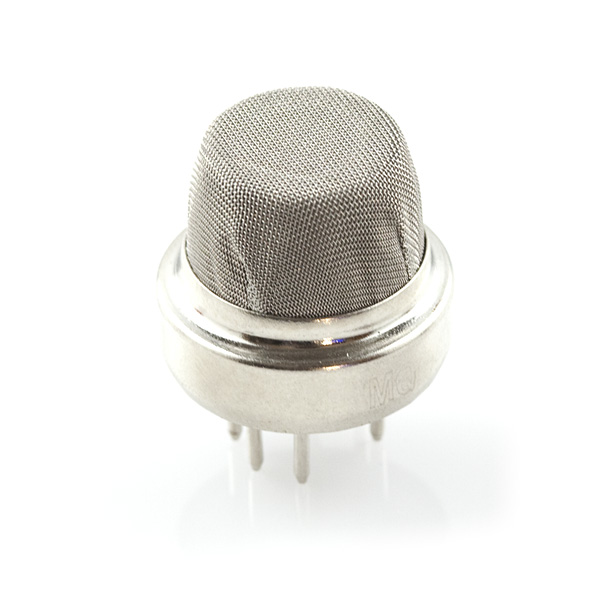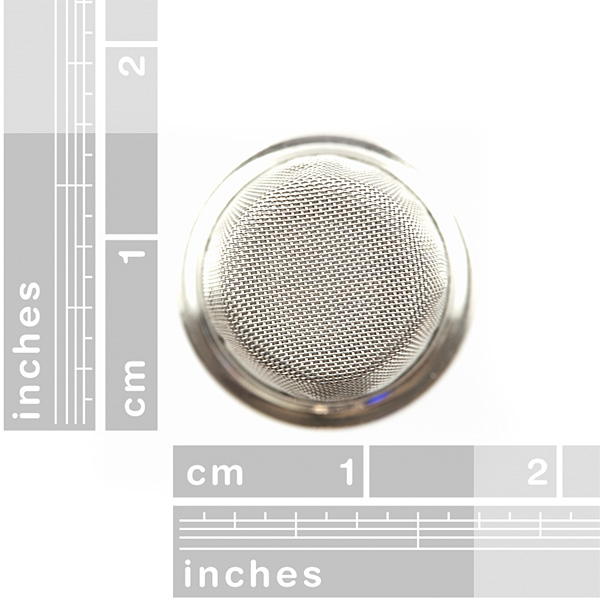This is a simple-to-use hydrogen gas sensor, suitable for sensing hydrogen concentrations in the air. The MQ-8 can detect hydrogen gas concentrations anywhere from 100-10000ppm.
This sensor has a high sensitivity and fast response time. The sensor's output is an analog resistance. The drive circuit is very simple; all you need to do is power the heater coil with 5V, add a load resistance, and connect the output to an ADC.
This sensor comes in a package similar to our MQ-3 alcohol sensor, and can be used with the breakout board below.
Hydrogen Gas Sensor - MQ-8 Product Help and Resources
Hazardous Gas Monitor
June 17, 2016
Build a portable gas monitor to check for dangerous levels of hazardous gases.
Core Skill: Soldering
This skill defines how difficult the soldering is on a particular product. It might be a couple simple solder joints, or require special reflow tools.
Skill Level: Noob - Some basic soldering is required, but it is limited to a just a few pins, basic through-hole soldering, and couple (if any) polarized components. A basic soldering iron is all you should need.
See all skill levels
Core Skill: Electrical Prototyping
If it requires power, you need to know how much, what all the pins do, and how to hook it up. You may need to reference datasheets, schematics, and know the ins and outs of electronics.
Skill Level: Noob - You don't need to reference a datasheet, but you will need to know basic power requirements.
See all skill levels
Comments
Looking for answers to technical questions?
We welcome your comments and suggestions below. However, if you are looking for solutions to technical questions please see our Technical Assistance page.
Customer Reviews
0 out of 5
Based on 0 ratings:



-------------------- Tech Support Tips/Troubleshooting/Common Issues --------------------
Pinouts
I checked with a multimeter and it does not matter if it's A or B on any of the gas sensors that is connected with the breakout board. If you look at the datasheet, it shows that the pins for A1 and A2 or B1 and B2 are internally connected together, respectively. Also the application circuit shows that the polarity does not matter, just as long as the pins on each side align with the breakout board.
Does this senor detect only hydrogen gas ??
Hi there, it sounds like you are looking for technical assistance. Please use the link in the banner above, to get started with posting a topic in our forums. Our technical support team will do their best to assist you.
As listed in the datasheet, hydrogen is the specific target gas. (Unfortunately, my chemistry is a little rough and I can't absolutely verify that hydrogen is the only gas in the universe that the SnO2 sensor will detect. However, people more knowledgable, than me, in that field have published papers on such topics.)
Will this detect an isotope of hydrogen such as deuterium?
Does this senor detect hydrogen sulfide?
I bought the following MQ8 sensor module. http://www.ebay.com/itm/MQ8-MQ-8-Hydrogen-Gas-Sensor-Module-for-Arduino-Gas-Sensor-module-/130897191077?ssPageName=ADME:X:AAQ:US:1123 and am using the code given at http://sandboxelectronics.com/?p=196. As per code the RL value after calibration should give values around at 10 k ohm. However I am getting very arbitary values like 20k, 100k etc. Can anyone plz explain this? Also, about a month back, when hydrogen gas was passed over the sensor, the output(ppm) would change instantly however now the output changes very sluggishly(over several minutes). Also it does not reach the final value. Could this be the effect of humidity or temperature? Can anyone suggest?
I bought the following MQ8 sensor module. http://www.ebay.com/itm/MQ8-MQ-8-Hydrogen-Gas-Sensor-Module-for-Arduino-Gas-Sensor-module-/130897191077?ssPageName=ADME:X:AAQ:US:1123 and am using the code given at http://sandboxelectronics.com/?p=196. As per code the RL value after calibration should give values around at 10 k ohm. However I am getting very arbitary values like 20k, 100k etc. Can anyone plz explain this? Also, about a month back, when hydrogen gas was passed over the sensor, the output(ppm) would change instantly however now the output changes very sluggishly(over several minutes). Also it does not reach the final value. Could this be the effect of humidity or temperature? Can anyone suggest?
How do i tell what the pin out on this is?
i made an adapter that might be useful for this to 1/4" hose http://www.thingiverse.com/thing:137312
I'm curious about the detection of Carbon Dioxide? I've seen a bunch of the MQ for a variety of different gasses, but none for CO2. Is this just really difficult to make at a consumer price?
Shit, I got some of these and some of the Methane sensors (http://www.sparkfun.com/products/9404) in the same shipment, and can't figure out which is which!
That's a predicament. I looked at the data sheet, and they appear to be exactly the same electronically and dimensionally. However, the Load Resistance and Heater Resistance is a little varied. Maybe try hooking it up and measuring these variables.
Or, (and I'm almost completely serious) you could fart on them and see which one reacts more ;)
Just noticed this on the data sheet: "Preheat time: Over 24 hour". The other gas sensors SFE sells also seem to have such pre-heat times.
This seems suitable for an always-on gas monitoring station, but not much use for a portable quick/brief-use type instrument. I guess it might work if you kept the instrument in hot-standby on a charging cradle...
That time refers to how long you have to keep it on when you first get it to "bake" the electronics properly. After that first 24 hour break-in period, you can, and should, use it with a lot shorter warm up time of a minute or so. Keeping it warmed up all the time will make it a lot less sensitive.
That's for when you want to reflow solder it ;)